Damage Adaptive Titanium Alloy by In-Situ Elastic Gradual Mechanism
Abstract
1. Introduction
2. Materials and Methods
2.1. Materials Preparation
2.2. Uniaxial Cyclic Tensile Tests
2.3. Fatigue Crack Growth Experiments
2.4. Microstructure Characterizations
3. Results
3.1. Mechanical Properties
3.2. Fatigue Crack Propagation Pattern
3.3. The Crack Branch in Tensile Fatigue Tests
4. Discussion
4.1. The Contribution of Elastic Gradient to Damage Tolerance
4.2. The Main Reason for Retardation in Crack Growth
4.3. The Elastic Gradient Mechanism in Ultrafine Materials
5. Conclusions
Author Contributions
Funding
Conflicts of Interest
References
- Zhang, C.; Chen, F.; Huang, Z.F.; Jia, M.Y.; Chen, G.Y.; Ye, Y.Q.; Lin, Y.J.; Liu, W.; Chen, B.Q.; Shen, Q.; et al. Additive manufacturing of functionally graded materials: A review. Mater. Sci. Eng. A 2019, 764, 138209. [Google Scholar] [CrossRef]
- Zhang, H.H.; Liu, S.M.; Han, S.Y.; Fan, L.F. The numerical manifold method for crack modeling of two-dimensional functionally graded materials under thermal shocks. Eng. Fract. Mech. 2019, 208, 90–106. [Google Scholar] [CrossRef]
- Fang, T.H.; Li, W.L.; Tao, N.R.; Lu, K. Revealing extraordinary intrinsic tensile plasticity in gradient nano-grained copper. Science 2011, 331, 1587–1590. [Google Scholar] [CrossRef]
- Gu, Y.; Zhu, W.H.; Lin, J.Q.; Lu, M.M.; Kang, M.S. Subsurface Damage in Polishing Process of Silicon Carbide Ceramic. Materials 2018, 11, 506. [Google Scholar] [CrossRef] [PubMed]
- Boland, J.N.; Li, X.S. Microstructural Characterisation and Wear Behaviour of Diamond Composite Materials. Materials 2010, 3, 1390–1419. [Google Scholar] [CrossRef]
- Li, Y.H.; Yang, C.; Zhao, H.D.; Qu, S.G.; Li, X.Q.; Li, Y.Y. New Developments of Ti-Based Alloys for Biomedical Applications. Materials 2014, 7, 1709–1800. [Google Scholar] [CrossRef] [PubMed]
- Li, P.Y.; Ma, X.D.; Tong, T.; Wang, Y.S. Microstructural and mechanical properties of β-type Ti–Mo–Nb biomedical alloys with low elastic modulus. J. Alloy. Compd. 2020, 815, 152412. [Google Scholar] [CrossRef]
- Tao, S.C.; Xu, J.L.; Yuan, L.; Luo, J.M.; Zheng, Y.F. Microstructure, mechanical properties and antibacterial properties of the microwave sintered porous Ti–3Cu alloys. J. Alloy. Compd. 2020, 812, 152142. [Google Scholar] [CrossRef]
- Kikuchi, S.; Yoshida, S.; Ueno, A. Improvement of fatigue properties of Ti-6Al-4V alloy under four-point bending by low temperature nitriding. Int. J. Fatigue 2019, 120, 134–140. [Google Scholar] [CrossRef]
- Guo, X.Y.; Zhao, L.F.; Liu, X.; Lu, F.G. Investigation on the resistance to fatigue crack growth for weld metals with different Ti addition in near-threshold regime. Int. J. Fatigue 2019, 120, 1–11. [Google Scholar] [CrossRef]
- Shi, Q.Y.; Hsie, S.A.; Jones, J.W.; Allison, J.E. Effects of alloying and processing on ultrasonic fatigue behavior in binary Ti-Al alloys. Mater. Sci. Eng. A 2019, 756, 564–577. [Google Scholar] [CrossRef]
- Suzuki, K.; Koyama, M.; Hamada, S.; Tsuzaki, K.; Noguchi, H. Planar slip-driven fatigue crack initiation and propagation in an equiatomic CrMnFeCoNi high-entropy alloy. Int. J. Fatigue 2020, 133, 105418. [Google Scholar] [CrossRef]
- Suzuki, S.; Sakaguchi, M. Fatigue crack retardation associated with creep deformation induced by a tension hold in a single crystal Ni-base superalloy. Scr. Mater. 2020, 178, 346–350. [Google Scholar] [CrossRef]
- Rozumek, D.; Lewandowski, J.; Lesiuk, G.; Correia, J.A. The influence of heat treatment on the behavior of fatigue crack growth in welded joints made of S355 under bending loading. Int. J. Fatigue 2020, 131, 105328. [Google Scholar] [CrossRef]
- Riedel, H. Fatigue crack growth in a material with coarse brittle phases. Int. J. Fatigue 2020, 131, 105332. [Google Scholar] [CrossRef]
- Qiu, B.; Kan, Q.H.; Kang, G.Z.; Yu, C.; Xie, X. Rate-dependent transformation ratcheting-fatigue interaction of super-elastic NiTi alloy under uniaxial and torsional loadings: Experimental observation. Int. J. Fatigue 2019, 127, 470–478. [Google Scholar] [CrossRef]
- Zhu, Z.Y.; Zhu, Y.L.; Dai, G.Z.; Wang, Q.Y. Microstructural evolution of strain rate related tensile elastic prestrain on the high-cycle fatigue in medium-carbon steel. Mater. Sci. Eng. A 2019, 764, 138224. [Google Scholar] [CrossRef]
- Myung, N.; Seo, J.; Choi, N.S. Cyclic elastic modulus and low cycle fatigue life of woven-type GFRP coated aluminum plates. Compos. Part B Eng. 2019, 174, 107004. [Google Scholar] [CrossRef]
- Meneghetti, G.; Ricotta, M.; Pitarresi, G. Infrared thermography-based evaluation of the elastic-plastic J-integral to correlate fatigue crack growth data of a stainless steel. Int. J. Fatigue 2019, 125, 149–160. [Google Scholar] [CrossRef]
- Kamaya, M. Elastic-plastic fracture resistance of carbon steel for cyclic load (prediction of J-R curve assuming fatigue crack growth). Eng. Fract. Mech. 2018, 204, 306–318. [Google Scholar] [CrossRef]
- Vantadori, S.; Carpinteri, A.; Cocoo, V.D.; Lacoviello, F.; Natali, S. Fatigue analysis of a near-equiatomic pseudo-elastic NiTi SMA. Theor. Appl. Fract. Mech. 2018, 94, 110–119. [Google Scholar] [CrossRef]
- Stinville, J.C.; Lenthe, W.C.; Miao, J.; Pollock, T.M. A combined grain scale elastic–plastic criterion for identification of fatigue crack initiation sites in a twin containing polycrystalline nickel-base superalloy. Acta Mater. 2016, 103, 461–473. [Google Scholar] [CrossRef]
- Koster, M.; Lis, A.; Lee, W.J.; Kenel, C.; Leinenbach, C. Influence of elastic–plastic base material properties on the fatigue and cyclic deformation behavior of brazed steel joints. Int. J. Fatigue 2016, 82, 49–59. [Google Scholar] [CrossRef]
- Pribe, J.D.; Siegmund, T.; Vikas, T.; Kruzic, J.J. Plastic strain gradients and transient fatigue crack growth: A computational study. Int. J. Fatigue 2019, 120, 283–293. [Google Scholar] [CrossRef]
- Li, P.Y.; Wang, Y.S.; Meng, F.Y.; Cao, L.; He, Z.R. Effect of Heat Treatment Temperature on Martensitic Transformation and Superelasticity of the Ti49Ni51 Shape Memory Alloy. Materials 2019, 12, 2539. [Google Scholar] [CrossRef]
- Zhang, H.Y.; Wang, C.; Zhang, S.Q.; Zhou, G.; Chen, L.J. Evolution of Secondary α Phase during Aging Treatment in Novel near β Ti-6Mo-5V-3Al-2Fe Alloy. Materials 2018, 11, 2283. [Google Scholar] [CrossRef]
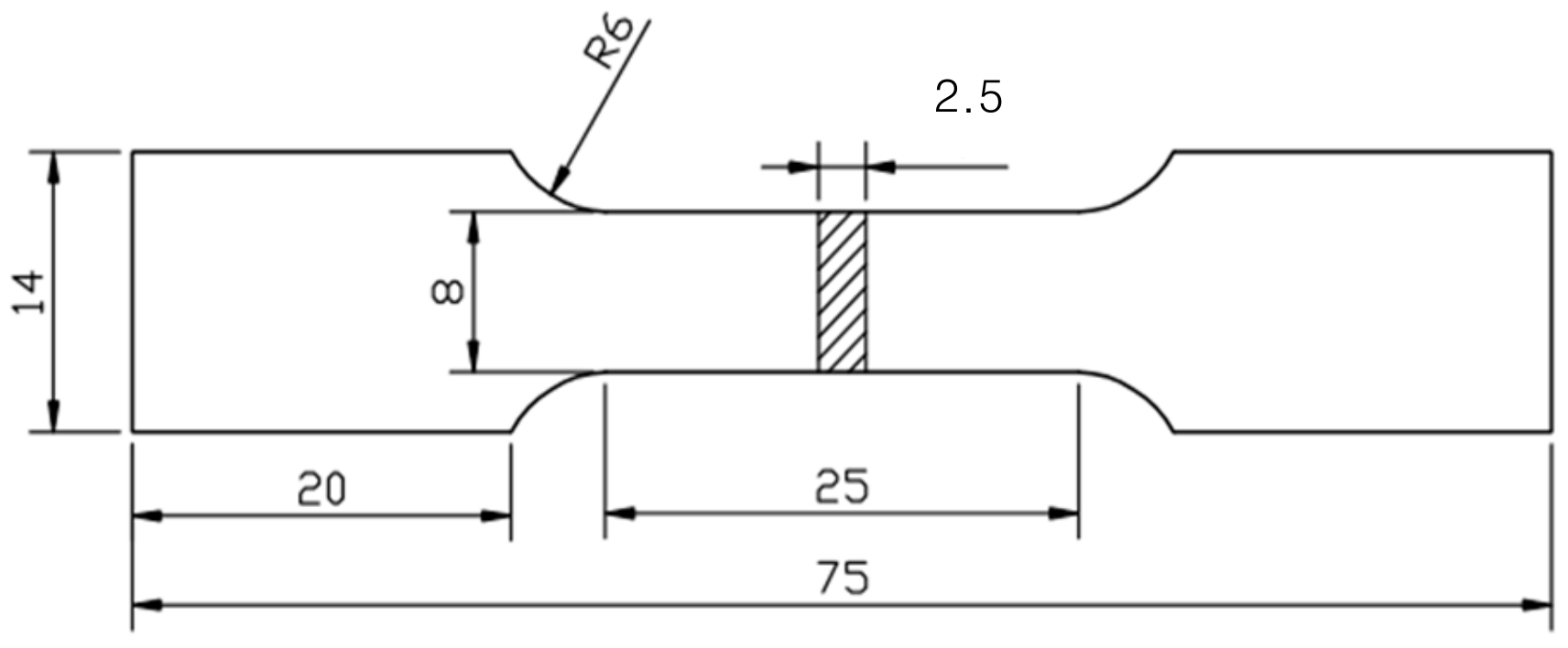
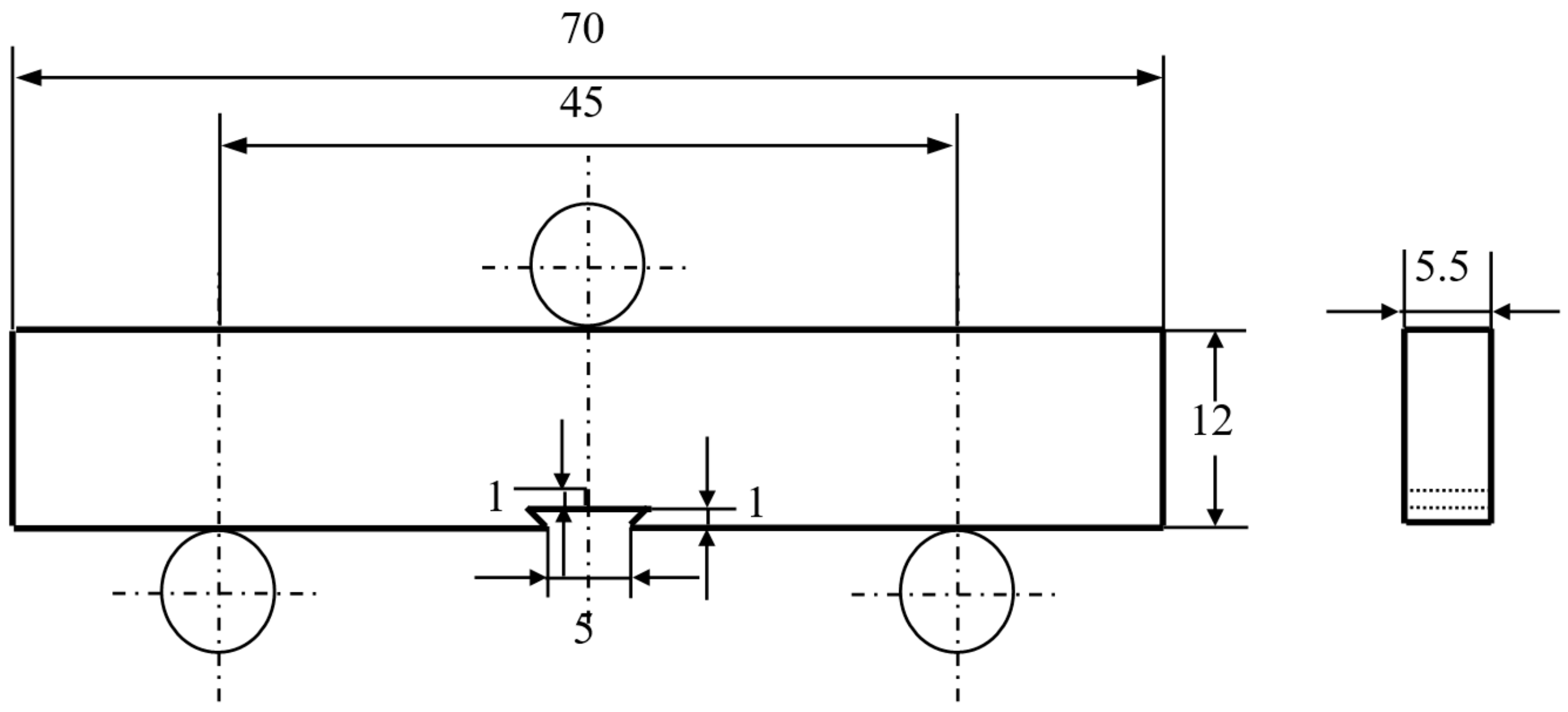

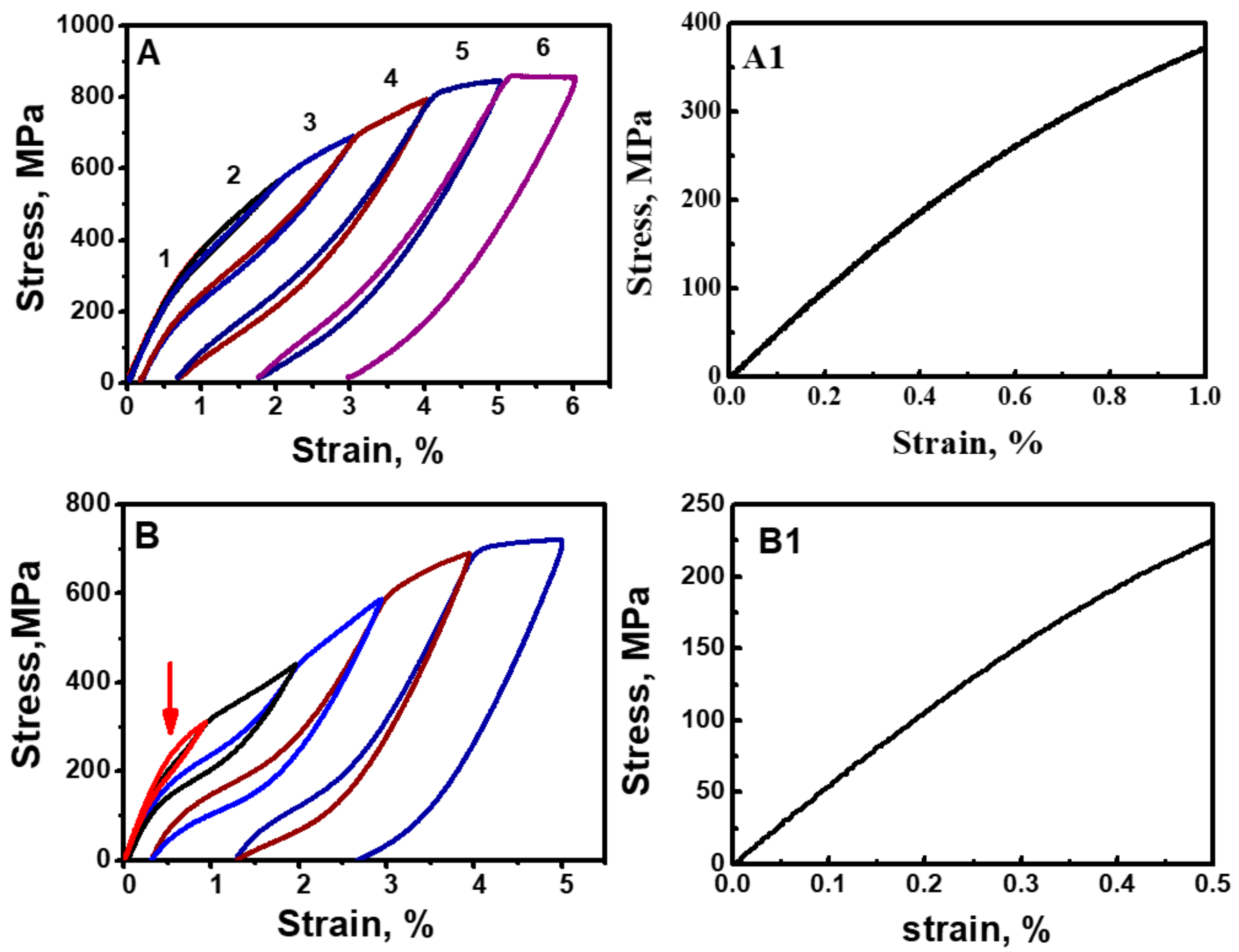
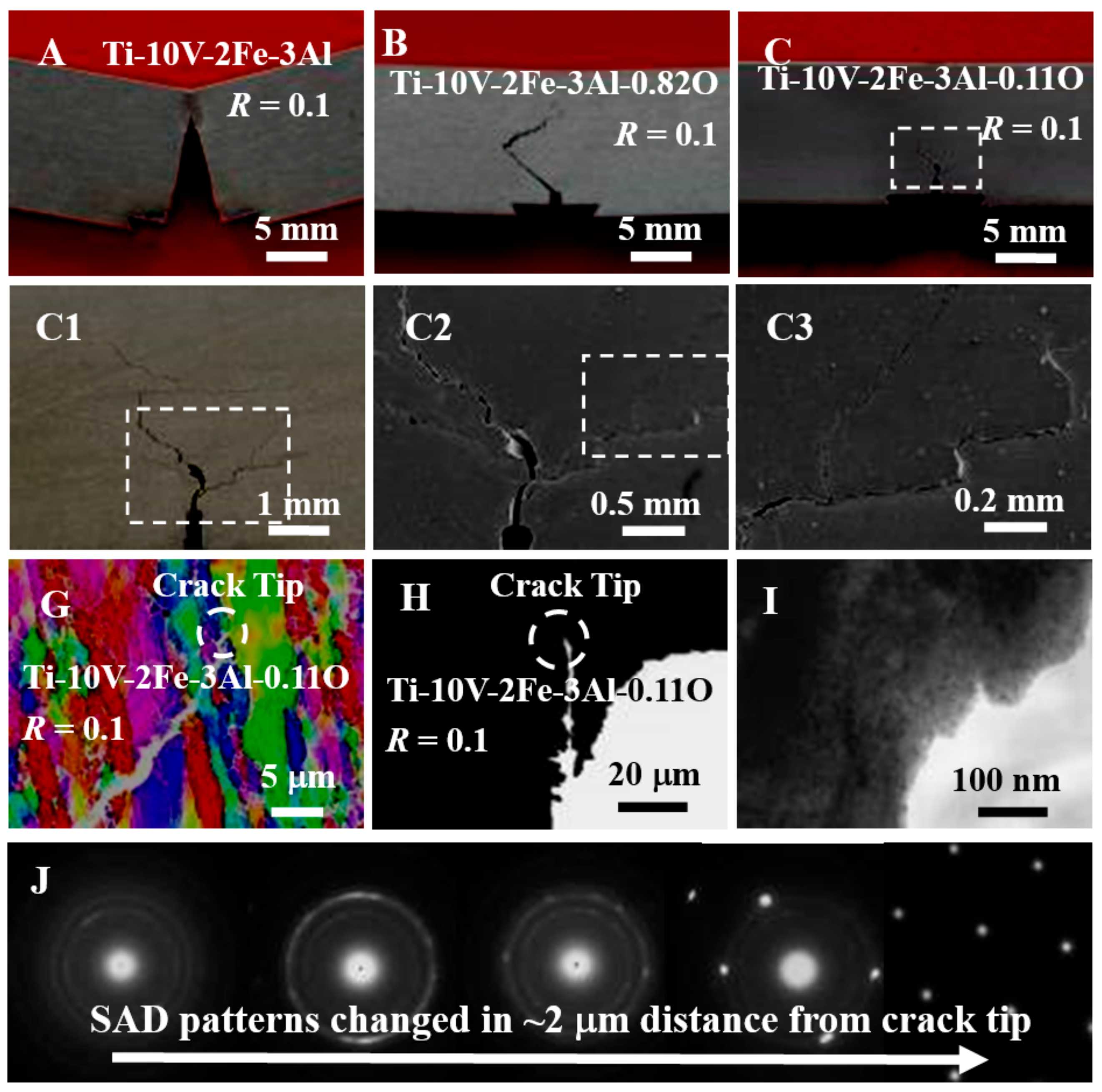

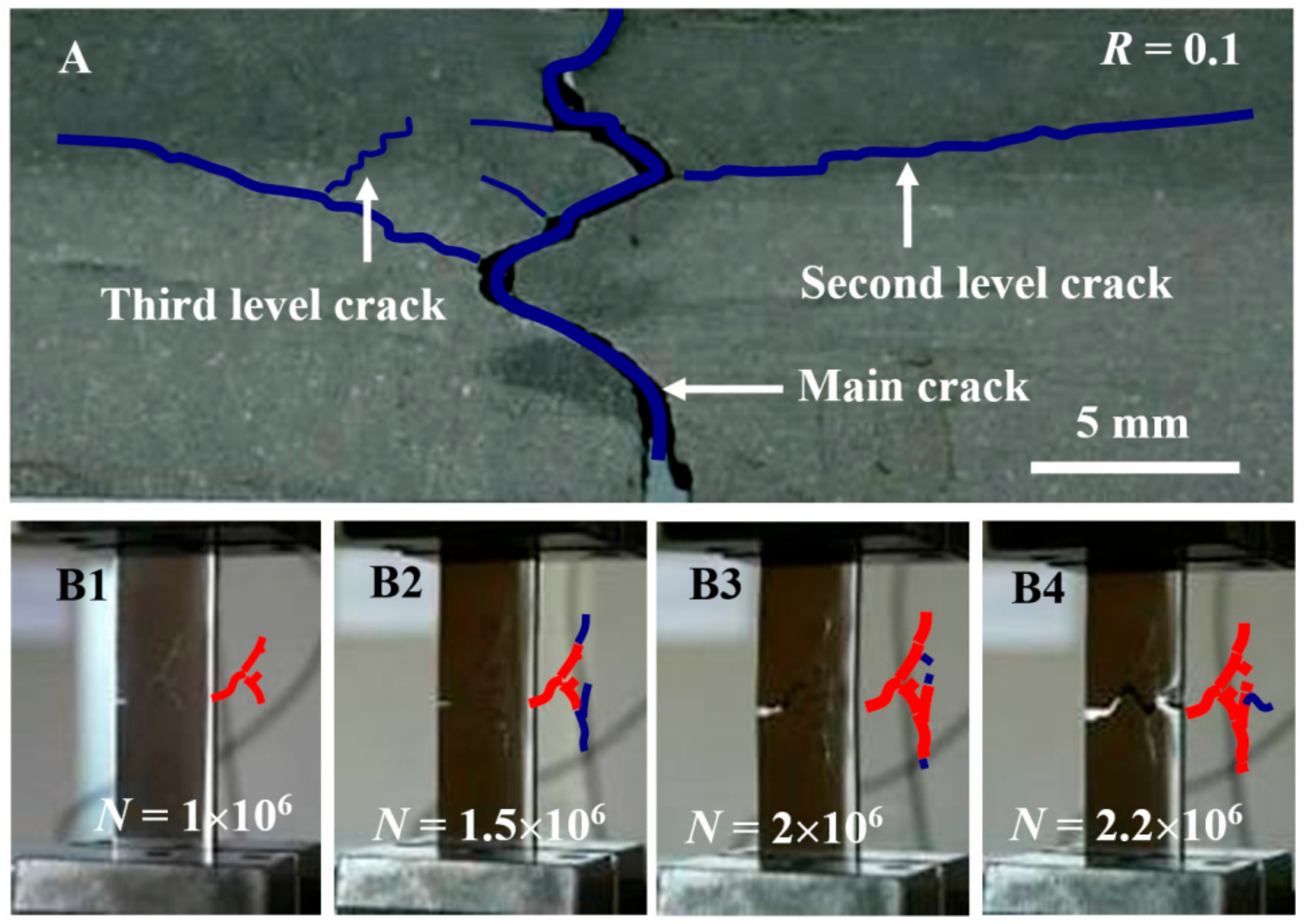
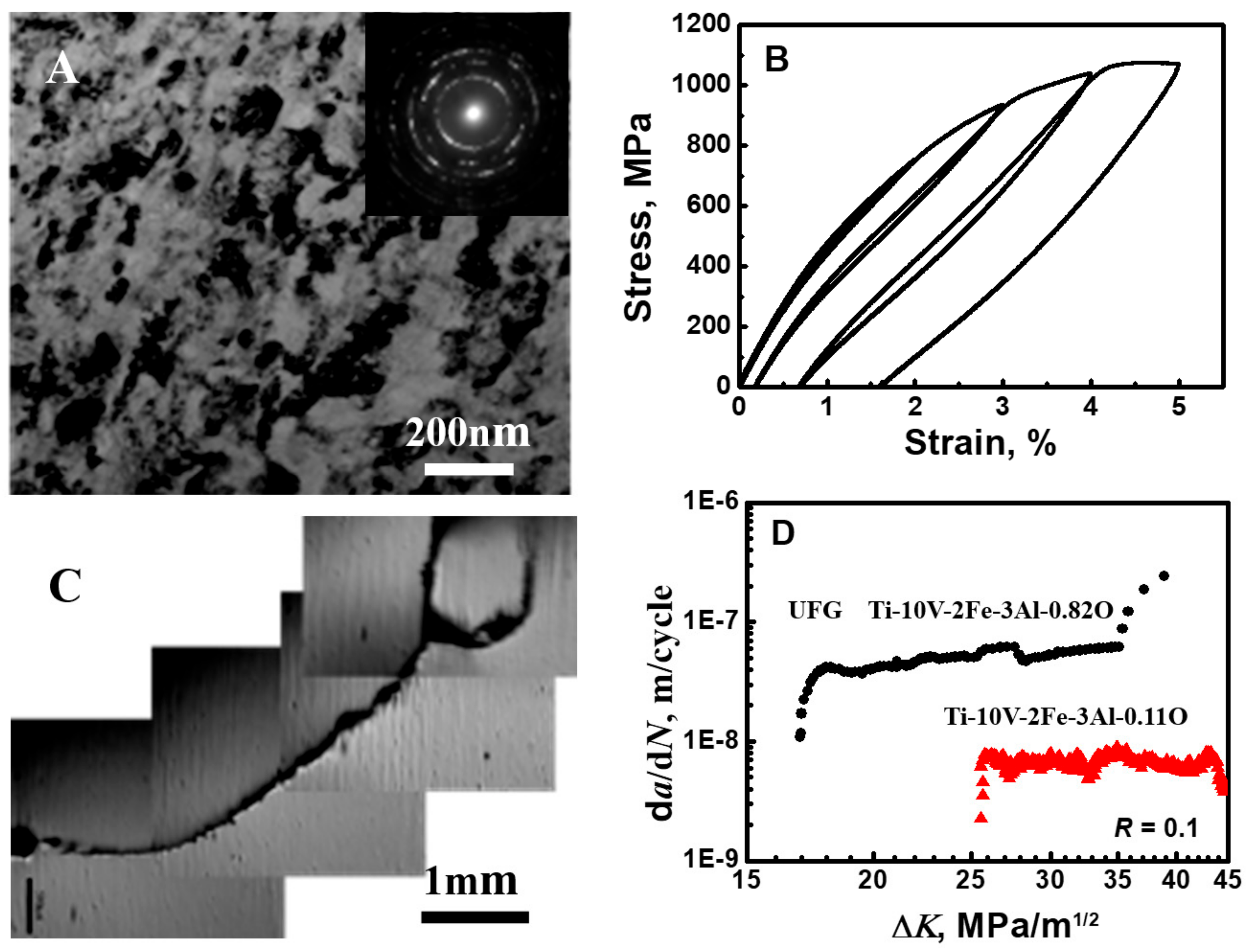
| Alloy | V | Fe | Al | O | Ti |
|---|---|---|---|---|---|
| Ti-10V-2Fe-3Al | 9.9 | 1.80 | 3.11 | 0.005 | Bal. |
| Ti-10V-2Fe-3Al-0.11O | 10.01 | 2.05 | 3.09 | 0.11 | Bal. |
| Ti-10V-2Fe-3Al-0.82O | 10.1 | 1.98 | 3.12 | 0.82 | Bal. |
© 2020 by the authors. Licensee MDPI, Basel, Switzerland. This article is an open access article distributed under the terms and conditions of the Creative Commons Attribution (CC BY) license (http://creativecommons.org/licenses/by/4.0/).
Share and Cite
Zhang, S.; Liu, J.; Zhang, H.; Sun, J.; Chen, L. Damage Adaptive Titanium Alloy by In-Situ Elastic Gradual Mechanism. Materials 2020, 13, 406. https://doi.org/10.3390/ma13020406
Zhang S, Liu J, Zhang H, Sun J, Chen L. Damage Adaptive Titanium Alloy by In-Situ Elastic Gradual Mechanism. Materials. 2020; 13(2):406. https://doi.org/10.3390/ma13020406
Chicago/Turabian StyleZhang, Siqian, Jing Liu, Haoyu Zhang, Jie Sun, and Lijia Chen. 2020. "Damage Adaptive Titanium Alloy by In-Situ Elastic Gradual Mechanism" Materials 13, no. 2: 406. https://doi.org/10.3390/ma13020406
APA StyleZhang, S., Liu, J., Zhang, H., Sun, J., & Chen, L. (2020). Damage Adaptive Titanium Alloy by In-Situ Elastic Gradual Mechanism. Materials, 13(2), 406. https://doi.org/10.3390/ma13020406





